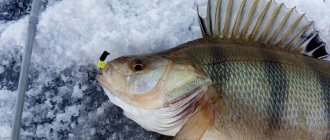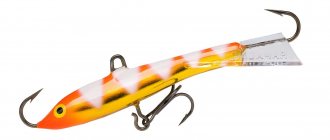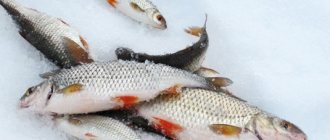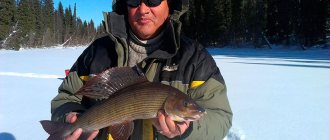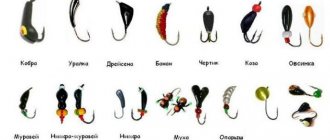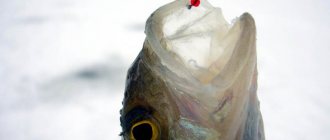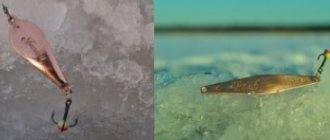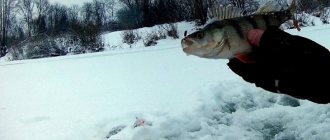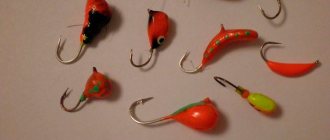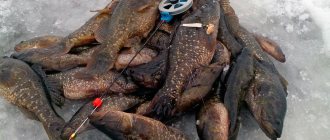Where to look for perch
So, the best time to catch perch is on the eve of winter. A week later, after the ice has formed, the activity of the perch increases sharply (it can be compared to a meal before spawning). Now, until severe frosts hit, the perch is in the coastal zone in its natural habitat. Preference is given to grassy or snagged shallows, headlands and bays. Perch loves a hard, pebble-sand bottom, strewn with snags.
It also lives on the bottom covered with silt, but there should not be too much of it. It can also be found on the border with aquatic vegetation or in places where other artificial and natural shelters are available.
Towards the end of December, the activity of perch decreases significantly, and in addition, previously large schools that formed in the fall disintegrate. Nowadays, finding a school of minke whales numbering over 10 individuals is a great success. The perch leaves the coastal zone, but as before, it tries to stick to the shallows that are adjacent to holes, river beds or dumps; there is a high chance of meeting it on the shallows between the holes. You should also look for perch in old river beds and in areas where rivers and streams flow into the reservoir. The depth at which perch prefers to stay is 2 - 3.5 m. You should look for perch in holes and pools only during periods of severe frost. Due to the decrease in the activity of stripers, catching perch in winter with a jig will be most effective, because a jig is the most delicate equipment.
At the beginning of spring, perch becomes active again and disperses throughout the entire reservoir; moreover, it can more often be found in various layers of water. This is especially true for large perch, which can be located a few centimeters from the ice edge.
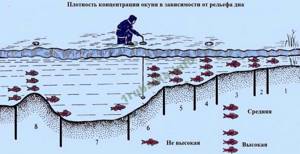
In winter, perch bite throughout the day; it is quite difficult to say which time is best for fishing for stripers, since now they are very capricious and can be passive all day long; once they start feeding, they feed only in the evening. It has been noted that the evening bite is the shortest.
Perch loves windless, frosty days, the main thing is that the atmospheric pressure is stable and the frost is not lower than 15˚C.
Selecting a location
Despite the fact that perch is quite active in winter and is found in almost every body of water, you need to approach the choice of fishing spot responsibly. The optimal depth, according to experienced fishermen, is considered to be a distance of one to two meters.
Of course, perch is also found at medium depths, but for the speed of lowering the tackle, it is still more convenient in shallow water. In addition, the features of the bottom topography should be taken into account. For parking, this type of predator chooses places with hard ground and all kinds of bottom irregularities, such as holes, edges, piles of stones.
You should also take a closer look at areas with trees fallen into the water and thickets of reeds. If the reservoir is equipped with a concrete fence, perch can be found in the place where the concrete slabs are replaced by soil.
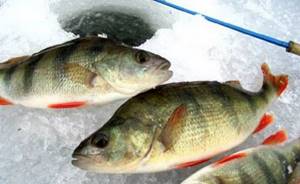
Catching perch in winter with a jig, search technique
We start making holes from the shore, and the colder and longer the winter lasts, the further we begin our search. We drill 10-12 holes in a checkerboard pattern at a distance of 5-10 meters from each other. When you drill holes near the shore, you must be careful not to let the drill come into contact with the bottom. Also, the knives of the drill can be dulled by sand blown onto the ice from the shore.
First, using not too thin equipment, catch all the active fish from the holes. Then go back and feed each hole with bloodworms, a pinch will be enough.
If you are fishing on a still body of water, it is enough to simply throw the bait into the hole; in the current, you need to use a feeding feeder, and the stronger the current, the lower at the bottom we should open it; as a rule, the feeder is opened by a strong hook. There is no need to knock the feeder on the bottom. After feeding, we check whether the fish has arrived, for which we make 4-5 retrieves. It is advisable to use several different jig movements. Moreover, winter fishing for perch using a standing jig is often successful.

The more confident the bite is and the more perch in the hole, the more often it is necessary to feed it, while reducing the number of bloodworms to 10-15 pieces.
Some anglers who have no problem with bloodworms feed the holes immediately after they have been drilled. In cases where there are not many bloodworms, throw only into those holes where stripers have bitten.
If the bite on a hole is weak, it makes sense to make an additional 1-2 holes within a radius of no more than 2 meters, perhaps the flock is standing somewhere nearby.
And remember, complementary feeding is secondary, if there is no bite, we move on and make the next series of holes. Winter perch fishing is an active type of fishing, and it doesn’t matter whether it’s a jig or a spoon. The larger the water area you fish, the more substantial the catch will be.
Looking for a place
Unlike pikes, perch usually moves in small schools, while single toothy predators occupy an area with a diameter of about 10-15 meters. Although it is easier to run into a flock of “striped” ones, you still cannot do without knowledge about their habitats.
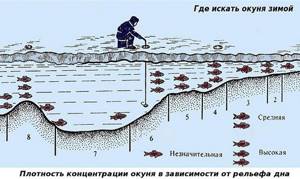
What we pay attention to first of all:
- “windows” in thickets of cattails or reeds;
- blockages from tree trunks or stones - perch is very fond of all sorts of “barricades”;
- places with snags and elevation changes;
- the tops of the edges;
- small holes near the banks.
Sometimes you may need an echo sounder - with its help, the fisherman determines the topography of the bottom surface. After freeze-up forms, the perch leads an “autumn” lifestyle for about three weeks - it remains active and feeds intensively. During the deep winter period, perches go to depths and to places with currents. This is due to a decrease in oxygen content in the reservoir and water temperature. It is ideal if during this period you find riverbeds and streams or deep holes - there, the oxygen level is much higher.
So-called undercurrents are often found on lakes; this happens in reservoirs from the bottom of which springs gush out - it wouldn’t hurt to visit these places either.
By the end of winter, the “striped ones” prepare to spawn, restoring the active feeding process. They return from the depths, following schools of fry. During this period, you need to look for perches in shallow waters, even better - near the mouths of streams, where small fish also gather, which our predator preys on.
In general, it is absolutely not necessary for the echo sounder to show fish. It will be quite enough for an experienced fisherman if the device provides data on the bottom topography.
More details about finding perch in winter are described in this article.
Tackle for winter fishing of perch with a jig
Rod
The stores offer a fairly wide range, but the most important thing when choosing is that the fishing rod should sit comfortably in the hand and there should be no feeling of awkwardness when playing with a jig. It is advisable that the handle be made of heat-insulating material so that your hands do not get so cold. The most common and popular among fishermen is the balalaika fishing rod. A special feature of this fishing rod is the reel, which is built into its body. The role of the reel here is to wind and store the fishing line; in principle, we don’t need anything else. The whip is quite thin and flexible.

An important component of any rod for catching perch in winter with a jig is the nod. You can buy it or make it yourself, for example, from polymer film or boar bristles. The main thing is that your guard matches the weight of the jig. The best option is when, under the weight of the jig, it is bent at an angle of 30 - 60˚ in relation to the ice surface. The length of the guard is 4-6 cm, the color is preferably bright, so it is visually easier to monitor the bite. It is advisable to always have at least 5-6 fishing rods with you, differing in the weight of the jig and the thickness of the fishing line. Well, or, as a last resort, several models of nods designed for the weight of jigs.
For convenience, it is necessary to write down the diameter of the fishing line and the weight of the jig on the rods in advance.
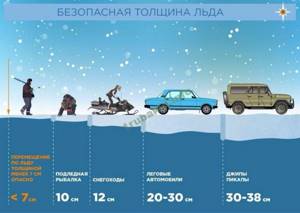
fishing line
Use quality fishing lines designed for winter fishing. As for the thickness, you need to start fishing with a coarser fishing line with a diameter of 0.9-0.12 mm, such a fishing line will be able to withstand a kilogram handsome one, and even in cases of active biting of smaller brothers, you will be able to quickly and confidently fish for stripers without fear break the line. Catching perch in winter with a jig when the bite is weak can become more effective if you switch to smaller jigs and thinner fishing line 0.06-0.07 mm. But remember that now when playing, you must be extremely careful. After drilling the hole, be sure to remove any ice from it and get rid of any sharp edges, since the line is quite thin and can be easily cut.

The amount of fishing line wound on a fishing rod depends on the depth of the reservoir where you are going to fish; as a rule, fishermen wind no more than 25 m of fishing line on one reel; in the absence of deep holes, 15 m will be enough.
It is advisable to always have a small hook with you so that you do not experience difficulties when catching a large specimen.
Manufacturers of jigs for winter perch - TOP 5
- Manufacturer Lucky John produces drop-shaped jigs that have good catchability and do not get caught on algae due to their successful shape.
- The Salmo company makes lures from tungsten and coats them with a protective film of powder paint, which makes them durable and different in color.
- The manufacturer Buzz Stix produces excellent baits that are successfully used specifically for winter fishing for perch and other fish.
- The Shark company produces baits of various shapes and sizes with a special galvanic coating.
- The Lucky John company produces high-quality baits that are incredibly popular among many anglers.
Choosing a jig for winter perch fishing
Material
A jig is a fishing hook soldered into a small piece of metal.
Jigs are made from:
- Lead;
- Tin;
- Tungsten.
When choosing, preference should be given to tungsten jigs, since they have the same weight and are smaller in size. In addition, many lead jigs have a dull hook.
Form
The shape of the jig can be:
- Drop;
- All around;
- Diamond-shaped;
- Curved (resembling a banana);
- In the form of a fly or other insect.
Color
Here, the opinions of fishermen vary greatly, some suggest bright jigs in order to intensify the bite in the dead of winter, others, on the contrary, say that this will scare away the fish.
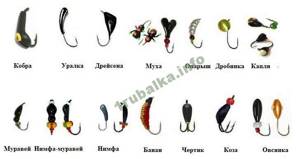
Catchable jigs
The point here is that in each body of water, perch behaves differently, and it is impossible to guess in advance what it will prefer. Therefore, you should always have a fairly wide arsenal of jigs of different shapes, weights and colors with you and alternate them while fishing.
But still, I would advise fishing with baits of natural colors during the period when perch is active.
In the wilderness:
- Depth up to 1.5 m - baits of dark tones or silver-dark;
- Depth from 2 m - silver, golden, yellow.
If this does not work, then use various bright and poisonous colors.
Jig weight for perch
At the beginning of spring and late winter, when the perch is active, it makes sense to use relatively large jigs of 3-4 and even 5 mm (according to the classification of sports jigs) or 0.3-0.4 g. (according to the classification of amateur jigs), the fish sees them from a greater distance, they are easier to play with, and the tackle sinks faster.
During the deep winter, when the perch becomes more passive, it is necessary to use delicate equipment, jig size 2-2.8 mm (or weight 0.2-0.3 g) at a fishing depth of up to 6 m.
As a rule, a jig is equipped with one solid hook, but there are cases when a tee is soldered in, such a jig is called a “devil”. Also, some hooks are connected to the pellet through a ring. This type of gear is called a “witch”.
They can fish with jigs with or without bait. As a rule, winter fishing for perch using a jig with an attachment is more effective than without it. You must have high professionalism in order to force a minke whale to attack a naked jig.
Top 7 catchy jigs for perch for winter
The following jigs are the most popular among anglers:
- “Banana” is probably the most popular and in demand jig among our fishermen.
Its curved shape and play are very attractive to the perch, forcing it to immediately attack the bait. Banana - Nail with brass ball — a feature of this jig is the presence of a brass ball on the underside, which slides freely along it during wiring. Winter fishing for perch with such a jig is very effective, since bites do not keep you waiting.
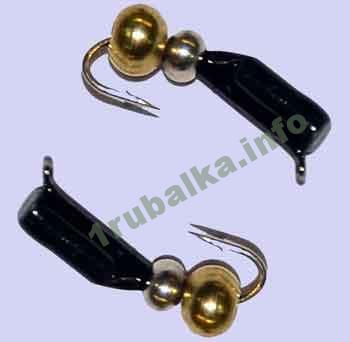
- A drop with a loop, the Salmo campaign has a rather interesting jig, its hook is soldered into the body at an angle that ensures the highest quality bites. In addition, polymer powder paint has a special protective layer, protecting it from excessive abrasion.
- Nymph - this jig has a spindle-shaped shape and wings (a set of plates, cambrics, and beads). When retrieving, the nymph imitates a larva in the water, so it is recommended to use nymphs of natural colors; the nymph also makes sounds during retrieving, which arouses additional interest in the fish. When choosing a nymph, be sure to pay attention to the fact that the attachment (plates, disks) should move freely.
“Devil” is also an equally catchy and time-tested bait. May have 2, 3 or even 4 hooks. Hooks can be either hard-soldered or suspended. It is best to use a three-hook jack. True, the catchability of this gear directly depends on the quality of the wiring and the balance of the equipment. Shark company has some pretty good electroplated bits.
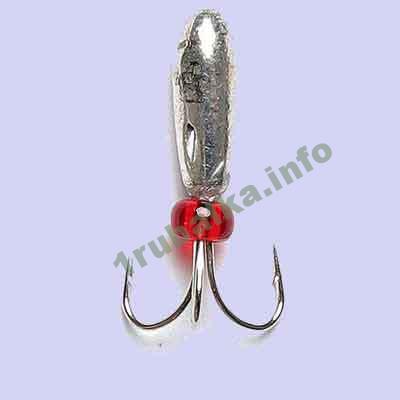
- Cat's eye feature of this jig is that there is an additional translucent bead placed on the hook, and the bead can also be attached using a staple. It is not so widespread and well-known, but those who use it praise it very much.
- Uralka jig has a slightly elongated and curved shape; when played, it creates a vibration field, giving the perch a signal to feed.
Catching perch in winter with the jigs mentioned above is successful both with and without baits. In addition, they are catchable for other fish species.
With and without bloodworms
Next, you need to decide which type of fishing you are a supporter of – baited or baitless (reelless). The fishing tactics are identical, but the baits are different. Reelless fishing is more active. It does not allow mistakes in the game, since there are no edible baits on the hook.
Catching perch with a jig with bloodworms requires, accordingly, greater emphasis on the bait, and not on the shape of the lures and their playing characteristics. In this article we will further analyze the nuances of bait fishing. A separate article covers the features of reelless perch fishing.

Mothless
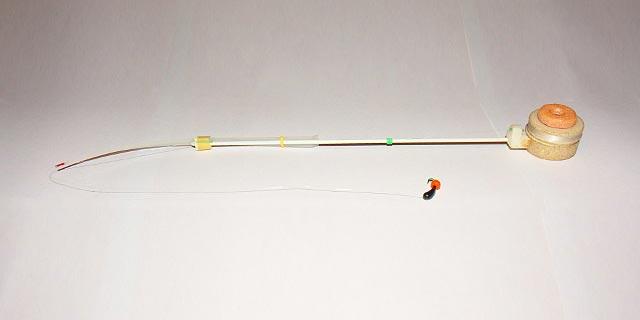
Reelless fishing rod
Nozzles
The best bait for fishing with a winter jig for perch is a live bloodworm. This is a natural food source. In addition, it is accessible to anglers. But if possible, you can use other baits:
- A piece of cow udder;
- A piece (strips) of raw liver;
- Burdock moth larva (Chernobyl);
- Mormysh;
- Shrimp meat;
- Maggot;
- Any living insect larvae;
- Caddisfly;
- Artificial bloodworms or artificial maggots.
Of course, due to its wide availability in fishing stores in winter, bloodworms are most often used as bait (and at the same time as groundbait). You also need to experiment with the method of attaching it to the hook while fishing. Perch can react differently to a single bloodworm, mounted in a ring or directly. For passive fish, it is better to attach generally 2-3 pieces, and when catching large fish, a bunch by hand or using a buncher.

Artificial bloodworm
Types of postings
Tapping method . For beginners and fishermen who do not like to be too clever, catching perch in winter with a jig is preferable to one simple, but quite catchy retrieve. We lower the tackle to the bottom and make three or four taps on the bottom, while the jig rises to a height of no more than 3-4 cm, after which the tackle sinks to the bottom, and we pull the fishing line. We wait in this position for 5-10 seconds and slowly unwind the tackle. At the same time, we are in constant readiness for a perch to bite, because it can be in different layers of water. In this way, two entries are made, and if there is no result, we move on to the next holes.
Stepped wiring . We lower the bait, and when there is about a meter left to the bottom, we begin to swing it from side to side, smoothly lowering it to the bottom. As soon as it reaches it, we wait a few seconds; quite often active fish bite at this very moment. If the bite does not occur, we again raise our jig to a height of 50 cm and begin to make circular movements with the fishing rod with gradual acceleration. Then the jig sinks to the bottom again. We repeat this wiring three times. It is on the third rise that the perch most often bites.
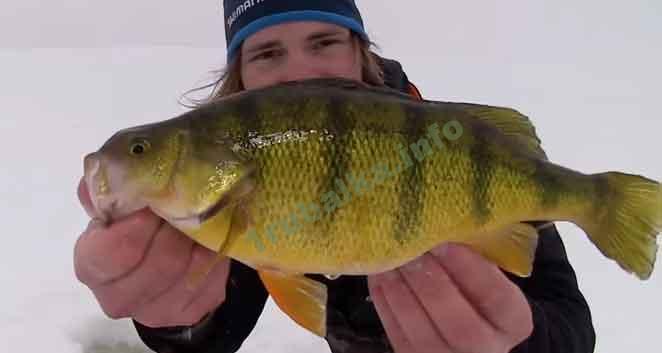
Combined wiring . We lower the jig into the hole and wait until it reaches the bottom. Now we lift the tackle 30-35 cm from the bottom and tug lightly, creating slight vibrations of the tackle. Then we put the jig on the bottom again and tap 4-6 times on the bottom and slowly raise it to a height of 6-8 cm, pause for 5-10 seconds and lower the jig back to the bottom. Then slowly raise the jig to a distance of 20-30 cm from the bottom and lightly, but at regular intervals, hit the whip with your finger for 20-25 seconds. The tackle is lowered back and the procedure is repeated several more times; if the perch does not respond, then we move on to the next hole. Winter fishing for perch with a jig with this type of fishing is quite effective, since it combines techniques that make the jig react differently.
Posting on the eve of spring. The essence of this wiring is that our game begins not in the bottom layer, but immediately at the edge of the ice at a distance of 60-80 cm. We smoothly lower the tackle to the bottom, while simultaneously swinging it from side to side. When the bait lies on the bottom, we perform 2-3 taps. Then we wait a little and knock again. Then slowly raise the jig 15-25 cm from the bottom and lower it again. After 20-30 seconds, we unwind the tackle and repeat the wiring again.
Features and nuances of fishing
The main secret of catching perch in winter with a jig is active search and constant experimentation. You need to understand that perch is extremely curious. Sometimes things that are not obvious at first glance work out. The subtleties of catching perch with a jig in winter:
- On a bright day, especially with transparent ice cover, it is better to look for minke whales in the shade, under cliffs, trees, and on dumps shaded from the sun.
- The holes in which they pecked need to be fed and covered with snow and slush, and then returned. A joyful, hungry flock of voracious predators can await the fisherman.
- A simple foam ball or a floating silicone fry on an additional hook that slowly sinks in the water can make fishing.
- Don't forget about bait. This has already been discussed above in the article.
- When actively fishing, monitor the condition of the bait on the hook. If you gape while fishing, the flock will leave, having noticed something more interesting somewhere.
- Perch loves mud on the bottom. She pulls him in. Therefore, when fishing with any bait, you should lift this mud by tapping on the bottom.
Subscribe to the channel:
My YouTube channel RYBAFAN on fishing:
We're OK
Bait and attachment for catching perch in winter with a jig
Groundbaits
- Groundbait No. 1 Mix bloodworms with breadcrumbs in a 1:1 ratio, then make balls and throw them into the pond.
- Groundbait No. 2 . We take the crumb of black bread and mix it with blood (you can buy it at the market) or “Albumin” in proportion to make a dough. Roll the dough into a sausage and freeze. At the pond we cut it and throw it into the holes.
- Bait No. 3. According to the principle of action, it resembles bait, since we lower the resulting balls into the holes three days before the start of fishing. Take finely chopped entrails (heart, liver, etc.). We add blood, bloodworms (chopped worms), then cereal or flour in sufficient quantities to give the bait viscosity and the ability to form balls from all this.
- Groundbait No. 4. A rather non-standard method, which consists in lowering a jar of small fish to the bottom, which will attract the perch with their appearance and will keep it at the fishing point for a certain time.

In addition to the above baits, you can use attractants and flavorings. For example, mix them with bread or breadcrumbs. You can also use aerosol baits to add a scent to the jig itself.
Bait
Catching perch in winter, even with a baitless jig, will be more successful if you put 1-2 bloodworms on the hook.
But it’s not just bloodworms that are of interest to winter perch. The fisherman can use the following baits:
- Chopped dung worm (in order to be able to use this attachment in winter, many fishermen store dung worms in boxes in cellars, periodically moistening the soil and adding vegetable waste there).
- Various bright pieces of insulation, polystyrene foam, beads, and woolen thread are especially effective in combination with no-attachment jigs.
- Dragonfly or caddisfly larva;
- Pieces of mussels or shellfish;
- Pieces of fish with fins sticking out (small perch you caught will do)
Lures
For winter fishing, fishermen use a range of baits, mainly baits (from the word “live”). Everything that is inanimate is bait. What do they bait on jig hooks:
- First of all, of course, the mosquito larva is the bloodworm.
- Fly larvae are also suitable for our case, and maggots are now painted in different colors. Bass generally like the color blue;
- the red worm remains relevant both in winter and summer;
- larvae of caddisflies and dragonflies.
Several attachments:
- artificial bloodworms or maggots;
- a piece of fish with a fin, and it is better if it is a perch itself (yes, this fish is characterized by cannibalism);
- perch eye with preserved iris! A very effective method, however, not all anglers like it.
As for artificial bloodworms and maggots, the issue remains controversial - manufacturers of such baits use various kinds of flavorings, but most people remain of the opinion that real bait is always better. In principle, you can try artificial analogues.
